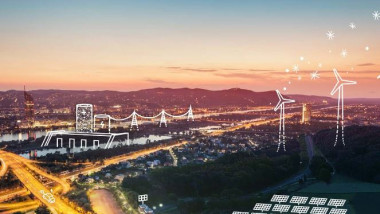Energy Transition: Innovation Gives Way To Consolidation
Highlights
- Mirova is doubling down on its proven approach of investing in energy transition developers, which get projects off the ground and then divest to the big utilities.
- The depth of its investment teams allows Mirova to continue to actively invest in the sector, navigating in higher inflation and interest rates and taking advantage of this period to enhance its return expectations.
- Recent transactions have demonstrated the possibility to structure deals with short term arbitrage, and possibilities to secure long-term stable cash flows, locking in high energy prices offtake for 10-15 years and hence, raising exit multiple.
- Thanks to the increasing maturity of the sector and its long track record, Mirova is now able to seek additional risk and return through corporate deals. These provide primary capital to developers willing to become independent power producers, in markets where growth potential is important for players capable of seizing the increasing opportunities driven by the acceleration of energy transition targets.
Energy transition has accelerated beyond most anticipations in the last five years, with private investment into renewable projects leading the charge. But can the pace of this investment be sustained amid an era of rising inflation, soaring interest rates and an accompanying retrenchment of risk?
“This is a time to consolidate and for investors like us to optimise their offerings,” says Raphaël Lance, Head of Energy Transition Funds at Mirova, an affiliate of Natixis Investment Managers. “For us, that means consolidating on our strategic expansions done of the last few years and reaping the benefits of the current market opportunities, without overextending ourselves.”
In fact, higher inflation and interest rates may even provide opportunities improved performance for investors with deep experience of the energy transition sector.
An intense period of innovation
Mirova can lay claim to being a very early energy transition pioneer. From a €50m investment in French wind farms in 2002, it has now funded more than €3.5bn1 in global energy transition building a network of strong partnership with lead developers of the sector across the globe.
Its portfolios feature a number of cutting-edge and evolving technologies such as, energy storage, energy efficiency, hydrogen and electric mobility, while adding up capacities in the traditional wind and solar generation.
Along the way, its focus gone beyond building renewable energy production capacity which supply energy directly to the grid to B2B projects, such as energy storage and installation infrastructure for electric vehicles.
And its geographic focus has expanded. Within Europe, its core western Europe remit now takes in Eastern Europe and the Nordic countries. Meanwhile, a major transaction has opened the way to Australia, while expansion in emerging markets occurred last year with the acquisition of SunFunder, a specialist in emerging market clean energy and climate investment. This gave Mirova a true global footprint and its investors greater exposure to agrisolar, e-mobility, solar home system, and commercial and industrial (C&I) solar.
It has expanded organically in APAC, with the recruitment to its Singapore team ramping up to eight locally-based investment professionals, with more to come. “It is vital to have fully-staffed teams on the ground to foster relationships with developers and gain access to deals,” notes Lance.
Time to double down
After this period of intense innovation and development, the prevailing economic and financial climate means it is time to consolidate, believes Lance. “We will use the experience which has served Mirova investors well for the last two decades to bed in all the innovation and focus on optimising performance.”
Mirova now has €29.9 billion AuM across its portfolios, with €3.5bn AuM in energy transition alone2. Its recent impact report shows it has financed more than 1,000 projects in 48 countries and funded 7.3GW of renewable energy installations. As a result, 660,000 people have new or improved energy access and 5,970 jobs have been directly supported in emerging markets. Out of 90 transactions, above 50 have been fully realized, showing a consistency in the ability of the team to deliver steady portfolio performance through the complete life cycle of the projects.
Amid higher interest rates and more business uncertainty, Mirova is doubling down on its proven approach. Lance says: “We will continue to focus on investing in small to mid size developers who get projects off the ground and be a one stop shop for them to foster their growth and build capacities to then sell to the big utilities who have distribution capabilities and are in desperate needs to grow their green asset bases.”
Mirova has made a series of senior hires from green energy development companies and utilities. Every member of Mirova’s 36-strong renewable energy team has a background in renewable energy, as well as core skills such as project financing, technical, project development, investment and asset management and ESG analysis.
These skills and experience help to create good industrial relationships, and this in turn leads to strong pipelines of deals, through referrals and repeat transactions. In the past three years, more than 500M€ have been invested annually by the Mirova energy team in mostly bilateral transactions with long-term partners.
The knowledge and experience in its teams allow Mirova to not only withstand the more challenging macro environment but exploit it. For instance, it has been able to restructure deals, locking in today’s high energy prices for the long run and providing a hedge to any future softening of energy markets.
Also, higher inflation may reduce returns from some assets, but for energy transition projects being structurally long in electricity, higher prices can mean higher profits. “Our exit multiples have risen significantly as a result of improved profitability,” adds Lance.
Diversification through private equity
More expensive financing leading to lower leverage, and acceleration of the market growth provides an opportunity for equity investors to invest directly into development companies, in addition to individual projects. Many of these fast-growing development companies are finding it harder to self-fund or to obtain funding from traditional sources and are willing to trade equity for a capital injection.
“We have added a corporate equity element to our portfolios and this is now approaching a significant portion of our allocations,” says Lance. “It is becoming a strong additional driver of performance.”
We are focusing on our historical partners who have proven their capabilities to develop projects and are willing to onboard and give away governance rights to an energy expert investor capable of understanding the markets, to support their growth with a strong alignment of interest and the same exit horizon,” says Lance. “Similar companies exist in the mobility space”, he adds.
These companies have typically sold maturing projects to larger utilities or derived fees from their projects to fund themselves. But with debt more expensive to obtain, they are looking for alternative sources of funding and welcoming a large minority investor is a good way to go.
The increasing maturity of the sector and Mirova’s long track record in the space, mean it is prepared to accept the additional risk and return provided by private equity-like deals. With IRR from plain vanilla infrastructure projects currently raising but still running at around 5-6%, a direct investment in development companies can provide significant uplift. “By investing directly in the companies, you get access to the assets, but also to strong development and growth potential,” says Lance.
“Investing in a mix of assets and companies is a great way to get more diversification given that companies can support a number of different technologies and projects at the same time.” This mix helps generate a combination of cash distribution and back ended capital gain for our investors.
Dealflow momentum
Competition for individual projects is increasing as the energy transition sector matures, but the pool of projects is deepening at the same time.
“There is currently a lot of fundraising and a lot of newcomers,” says Lance. Fortunately, there is also great financial need, with hundreds of billions – at the minimum – needed for energy transition, mobility transition and the decarbonisation of industry and the accompanying focus on emerging green hydrogen and e-fuel projects.
In addition, while high interest rates reduce liquidity overall, energy transition has moved to the top of the agenda for investors, so flows show few signs of slowing.
The global political consensus around energy transition favours continued investment. The European Union has set itself the goal of reducing net greenhouse gas emissions by 55% from 1990 levels by 2030, and ensuring that 42.5% of its total energy use is via renewables by the same date. In addition, it has a target of reducing overall energy consumption across the bloc by 11.7%.
Asia is moving in the same direction, with China leading the world in the construction of wind and solar facilities. Under its 12th Five-Year Plan, China set ambitious targets for wind and solar, supported by subsidized feed-in tariffs.
In the US, the trend towards clean or renewable energy is also accelerating. Fourteen states, plus Puerto Rico and the District of Columbia, have 100% clean or renewable energy targets.
Potential for risk-adjusted outperformance
For experienced investors who understand the risks, the returns on offer from energy transition should comfortably outperform those of traditional assets on a risk-adjusted basis.
“For our investors in the last few years we were targeting 8%-9% net IRR, but this is now coming in double digit because of higher power prices and all optimisation that an experienced asset manager like us can bring to projects” says Lance.
Performance could be further boosted by the corporate component. Lance says: “investing in companies can be more volatile, but successful investments can generate much higher IRR and our portfolios performance should reflect it. With the raise of interest rate, investors are expecting such premium for their infrastructure investments.
“Of course, all this is predicated on Mirova doing this for over 20 years. You really don’t want to be doing this for the first time in the current environment.”
Published in October 2023.
Mirova
Mirova is an affiliate of Natixis Investment Managers.
Portfolio management company - French Public Limited liability company
Regulated by AMF under n°GP 02-014
RCS Paris n°394 648 216
59, Avenue Pierre Mendes France – 75013 – Paris.
www.mirova.com
Natixis Investment Managers
Natixis Investment Managers is a subsidiary of Natixis.
Portfolio management company - French Public Limited liability company
RCS Paris n°453 952 681
43, Avenue Pierre Mendes France – 75013 – Paris.
www.im.natixis.com
This communication is for information only and is intended for investment service providers or other Professional Clients. The analyses and opinions referenced herein represent the subjective views of the author as referenced unless stated otherwise and are subject to change. There can be no assurance that developments will transpire as may be forecasted in this material.
Copyright © 2023 Natixis Investment Managers S.A. – All rights reserved





 Across the Universe #2 - The Energy Transition
Across the Universe #2 - The Energy Transition
 Mirova Energy Transition Infrastructure
Mirova Energy Transition Infrastructure